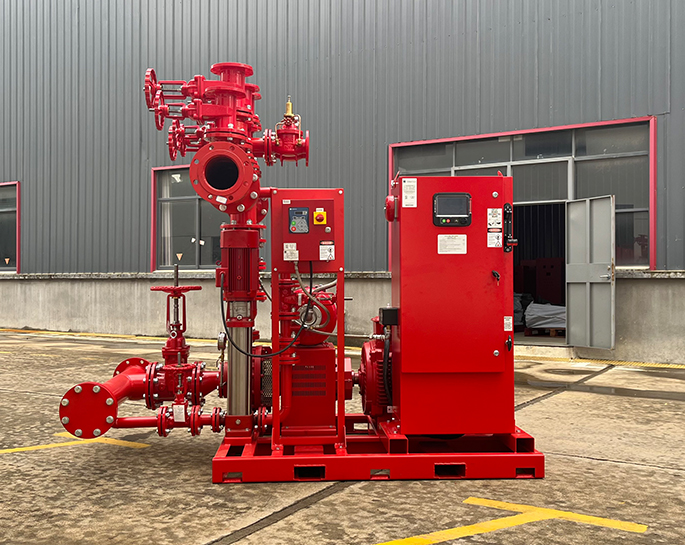What factors should be considered when selecting a fire pump?
May 13, 2024
Share:
Selecting the right fire pump is crucial for ensuring effective fire protection in a building or facility. Several factors should be considered during the selection process:
1. **System Design Requirements**: Understand the specific requirements of the fire protection system, including flow rate, pressure, and duration. This information is typically determined by factors such as building size, occupancy type, fire hazards, and local regulations.
2. **Type of Fire Pump**: Choose between various types of fire pumps, such as centrifugal pumps, vertical turbine pumps, or positive displacement pumps, based on factors like system design, available space, and the type of water supply (e.g., city water, onsite storage tanks).
3. **Reliability and Performance**: Assess the reliability and performance history of the fire pump manufacturer and model. Look for pumps that have a proven track record of reliability, efficiency, and compliance with relevant standards.
4. **Power Source**: Determine whether the fire pump will be electrically driven, diesel engine-driven, or steam turbine-driven. Consider factors such as availability of power sources, backup power options, and reliability requirements.
5. **Space and Installation Requirements**: Evaluate the available space for installing the fire pump and associated equipment. Consider factors such as footprint, clearance requirements, and access for maintenance and repairs.
6. **Compliance with Standards**: Ensure that the selected fire pump meets all applicable codes, standards, and regulatory requirements, such as NFPA 20, local building codes, and insurance company specifications.
7. **Manufacturer Support and Service**: Choose a reputable manufacturer that offers reliable support, training, and maintenance services. Consider factors such as warranty coverage, availability of spare parts, and technical support.
8. **Lifecycle Costs**: Consider the lifecycle costs of the fire pump, including initial purchase price, installation costs, maintenance expenses, and energy consumption. Opt for a pump that offers the best balance of upfront costs and long-term operational efficiency.
9. **Environmental Considerations**: Assess the environmental impact of the fire pump, such as energy efficiency, emissions, and compliance with environmental regulations.
10. **Future Expansion and Flexibility**: Anticipate future changes or expansions to the fire protection system and select a pump that offers flexibility for accommodating future needs, such as additional flow capacity or compatibility with new technologies.
By carefully considering these factors and consulting with fire protection experts, building owners and engineers can select the most suitable fire pump to meet the specific needs of their facility while ensuring compliance with regulations and standards.

1. **System Design Requirements**: Understand the specific requirements of the fire protection system, including flow rate, pressure, and duration. This information is typically determined by factors such as building size, occupancy type, fire hazards, and local regulations.
2. **Type of Fire Pump**: Choose between various types of fire pumps, such as centrifugal pumps, vertical turbine pumps, or positive displacement pumps, based on factors like system design, available space, and the type of water supply (e.g., city water, onsite storage tanks).
3. **Reliability and Performance**: Assess the reliability and performance history of the fire pump manufacturer and model. Look for pumps that have a proven track record of reliability, efficiency, and compliance with relevant standards.
4. **Power Source**: Determine whether the fire pump will be electrically driven, diesel engine-driven, or steam turbine-driven. Consider factors such as availability of power sources, backup power options, and reliability requirements.
5. **Space and Installation Requirements**: Evaluate the available space for installing the fire pump and associated equipment. Consider factors such as footprint, clearance requirements, and access for maintenance and repairs.
6. **Compliance with Standards**: Ensure that the selected fire pump meets all applicable codes, standards, and regulatory requirements, such as NFPA 20, local building codes, and insurance company specifications.
7. **Manufacturer Support and Service**: Choose a reputable manufacturer that offers reliable support, training, and maintenance services. Consider factors such as warranty coverage, availability of spare parts, and technical support.
8. **Lifecycle Costs**: Consider the lifecycle costs of the fire pump, including initial purchase price, installation costs, maintenance expenses, and energy consumption. Opt for a pump that offers the best balance of upfront costs and long-term operational efficiency.
9. **Environmental Considerations**: Assess the environmental impact of the fire pump, such as energy efficiency, emissions, and compliance with environmental regulations.
10. **Future Expansion and Flexibility**: Anticipate future changes or expansions to the fire protection system and select a pump that offers flexibility for accommodating future needs, such as additional flow capacity or compatibility with new technologies.
By carefully considering these factors and consulting with fire protection experts, building owners and engineers can select the most suitable fire pump to meet the specific needs of their facility while ensuring compliance with regulations and standards.


.png)
.png)

.png)


